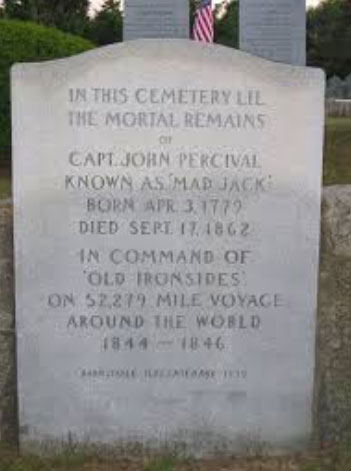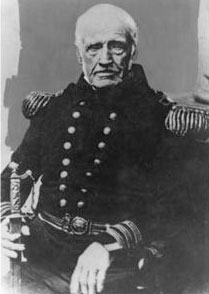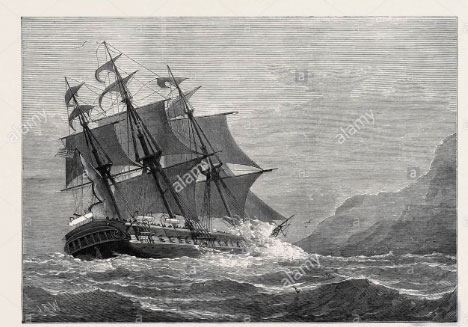Some early thoughts from Arrias on July 4th…and the REAL Old Navy.

If you are ever find yourself riding along Route 6A in West Barnstable (the “north side” of Cape Cod), drop by one of the old cemeteries and find the grave of Captain John “Mad Jack” Percival.
Jack Percival was one of those characters who seems to have stepped from the pages of a novel, born in 1779 in Barnstable, Massachusetts. His biographer described him as “controversial, irritable, short-tempered, contentious. But also courageous, warm-hearted and a highly skilled seaman.” He served in 4 different wars, to include being an impressed seaman on board HMS Victory in 1797.
Legend has it that he first decided to go to sea after a fight with his father at age 13. Furious with his father for some reason, he climbed a tree and sat in it, thinking. After a while, he decided he would either go home, or leave – depending on how his walking stick landed after he threw it out of the tree. He threw it, and it landed and pointed generally in the direction of Boston. Off he went, and became cabin boy and cook on a Boston “coaster.”
By the time the War of 1812 came around, Mad Jack had a well developed reputation for seamanship and action. He had nearly 20 years at sea, been impressed by the Royal Navy, made master of his own ship, joined the US Navy, left the US Navy (twice) and shortly after the War of 1812 started he returned to the US Navy yet again.
By the spring of 1813 the Royal Navy, with 85 ships in US waters (the US had just 6 ships when the war started), easily blockaded the major ports; New York was at the top of that list. HMS Poictiers (74 guns), the flagship of Commodore J.B. Beresford, maintained station just outside Sandy Hook, supported by her squadron and, in particular, by a schooner HMS Eagle, the flagship’s “tender.”
Eagle soon developed a nasty reputation among the local fishing fleet for harassment and, one may suppose, the regular seizing of the fishermen’s catches.
Commodore Jacob Lewis, the US Navy commander of the port of New York decided something ought to be done about Eagle; Percival volunteered to be the man to do it. He quickly developed a plan and Lewis approved it… Percival found a fishing smack on the East River that suited his needs – and conveniently named Yankee. He then selected 36 men – all well armed with muskets, from the Naval Base at Mosquito Cove (Glen Cove on Long Island), and on the 3rd of July hid 34 of them in the hold of the smack. Percival and two other men dressed as fishermen, with their deck loaded with livestock. Early on the morning of the 4th of July, as Percival told it, Yankee “stood out to sea as if going on a fishing voyage to the banks.”
Eagle’s commander soon spotted Yankee – and the animals on her deck. His thoughts almost immediately would have focused on the idea of fresh meat for dinner – the bait was taken. Eagle’s commander – Master Morris – ordered Yankee to proceed to Poictiers and to offload his livestock. Percival answered with a crisp “Aye, aye,” then put up his helm.
When they were less than 10 feet out Percival gave the signal – shouting “Lawrence” in honor of the slain Captain James Lawrence – and his men poured out of the hold and began firing. Eagle’s crew – to a man – fled below decks, before they had time to fire their heavy 32-pounder, which would have smashed Percival’s smack if it had hit her. One man of Eagle’s crew then came on deck and struck their colors. Percival brought Eagle back into port, landing his prisoners at Whitehall, “amidst the shouts and plaudits of thousands of spectators assembled on the Battery celebrating the Fourth of July.” As was later noted, Percival “Knew how to celebrate July 4th without listening to a band concert.”

This was not the end of his career by a long shot; among a long list of achievements, he captained the US Schooner Dolphin on one of the most amazing voyages of the first half of the 19th century, well documented in the journal by one of his Lieutenants in the straightforward – but long-winded titled – “A Journal of the Cruise of the United States Schooner Dolphin among the islands of the Pacific Ocean, and a visit to the Mulgrave Islands, in Pursuit of the Mutineers of the Whale Ship Globe – with a map” — a “cruise” that lasted from August 1825 to July 1826 on a ship just 88 feet long, with a 23 foot beam. His visit to Hawaii during that cruise is still remembered – in a slightly altered way, but more about that at another date.
Later, he saved USS Constitution from the breakers and then commanded her on a round-the-world deployment.
So, remember Captain “Mad Jack” Percival and the crew of Yankee and have a Great 4th of July!

Copyright 2019 Arrias
www.vicsocotra.com
